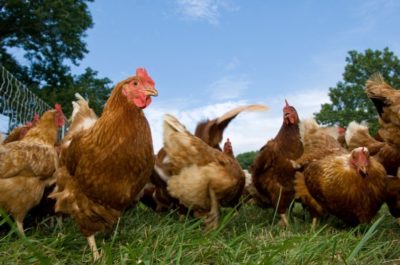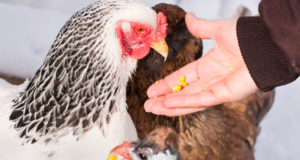 Chickens are notorious for acting normal when sick, until they fall over. However, when you know what to look for and take a few extra minutes to look over your flock, you can catch things early and help healing and recovery begin before it’s too late.
Chickens are notorious for acting normal when sick, until they fall over. However, when you know what to look for and take a few extra minutes to look over your flock, you can catch things early and help healing and recovery begin before it’s too late.
Pick a time of day to scan your flock. Maybe first thing in the morning when you let them out of their coop. You can look over them in the henhouse or watch as each one exits the coop. Be sure to keep count and check inside if anyone is missing. If “morning” is a bad word in your house, consider checking your flock in the evening as they settle in their coop for the night. Make sure everyone is accounted to look for anything out of the ordinary.
Below I look at illnesses that affect the head, beak, eyes, wings and body of chickens. I’ll be looking at illnesses that affect the crop, vent, feet and legs in part two of this article.
Head, Beak, And Eyes
1. If a chicken’s comb or wattles are discolored in colder weather, frostbite is a pretty good guess. Paler or blackened portions indicate frostbite while reddened areas are evidence of frostbite that has thawed. Frostbite can be more of a concern for chickens with larger wattles and combs (ornamental ones especially), but any chicken can suffer from frostbite in frigid weather. To help prevent frostbite, try to increase ventilation in your chicken coop to remove lingering moisture. Consider supplementing your coop with some heat, too. If the frostbite is severe, consult your veterinarian. Pain medicine may be appropriate. Gradually warm the affected areas with a warm cloth. Don’t rub, as that can cause further tissue damage. Watch your chicken to ensure it’s eating and drinking. Frostbitten combs and wattles can bump up against waterers and feeders, causing pain. It can take a while for recovery, so keep an eye on your flock and watch the weather to head off problems early on.
2. Cloudy or watery eyes can signal conjunctivitis. This condition most commonly occurs in coops with significant ammonia build-up, like in deep litter systems where the bedding has accumulated. The best way to prevent this condition is by cleaning out the coop often. Contact your vet for some antibiotics if you don’t see rapid improvement. Blindness can result if not treated promptly.
Packed full of information on some of the key aspects of raising chickens.
3. Swollen pus-filled eyes or matted eyelids are characteristic of eye worms. These white creatures appear more commonly in the South and are carried by cockroaches. Prevention focuses mainly on eradicating any lingering cockroaches who harbor the worms. Typical chicken wormers won’t kill them. There are some worming solutions that can be used to flush the affected eye out. So, if your chicken contracts these nasty little creatures, separate it out from your other chickens to help prevent the parasites spreading and call your vet to see what they recommend.
4. Sneezing, wheezing or coughing are evidences of respiratory illnesses, like bronchitis or coryza. These spread rapidly through a flock, so at the first cough or sneeze, separate the affected chicken out and watch the rest of the flock. The best way to prevent respiratory diseases is to practice biosecurity. Keep any equipment you use with your birds scrubbed and clean and don’t share it with other chicken owners. If you visit another flock, don’t handle your own flock until you change and wash your hands thoroughly. Quarantine any new birds, birds returning from shows, or sick animals for at least two weeks and preferably longer, especially if the animal doesn’t “seem right.” Call your vet and explain the bird’s symptoms. Some antibiotics can be prescribed and the vet will advise you as to whether you should treat your whole flock. Respiratory illnesses can kill. Sadly sometimes the best recommendation is to cull the ailing bird(s) before the illness spreads to the rest of your flock.
Wings And Body
5. An egg bound hen will often have closed eyes and dragging wings. Her tail will be down, and she may be straining or walking like a penguin. This is a serious condition and if no relief is achieved for the hen, she will most likely die within 24 to 48 hours. It’s always best to call your vet for advice, but you can try giving the bird some extra calcium by injection, liquid or via vitamins and electrolyte solution. If you need to, you can try giving this with a syringe or eye-dropper, but if she is extremely weak, don’t force her. You can put your hen in a shallow tub of warm water. This will help hydrate her vent and relax her and may be enough for her to pass the egg. After the bath, you can apply some KY jelly to the cloaca to further hydrate it. You can massage, ever so gently, the area around the egg to encourage the egg to move towards the vent. Be very, very careful not to break the egg though. Put your hen in a darkened, quiet room and wait for her to pass the egg on her own. If she still does not pass it, there is the possibility of manually removing it for her, but this can be quite dangerous and space does not allow for an explanation here. It’s best to consult with your vet.
Spotting illnesses early is a key determining factor in the recovery of any ill members of your flock. Keeping the above symptoms in mind and practicing good observation can help you stay “in-tune” with your flock and be aware the moment something is off. Hopefully your flock will stay healthy and carefree, but should something come up, may the above help you catch it early, treat it decisively and help you bring your flock back up to maximum health and production!
Sign up for Off The Grid News’ weekly email and stay informed about the issues important to you
 Off The Grid News Better Ideas For Off The Grid Living
Off The Grid News Better Ideas For Off The Grid Living




